
Royal Palm visitors find natural beauty
FLORIDA CITY, Fla. — Four miles from the main entrance of the well-known Everglades National Park here, a humble Visitor Center sits with eager employees awaiting their next visitor.
This location, known as the Royal Palm Nature Center, is surrounded by wetlands and is aligned by grainy, old stones on the walkways. At this time of year, mosquitoes are scarce and humidity is no longer an issue.
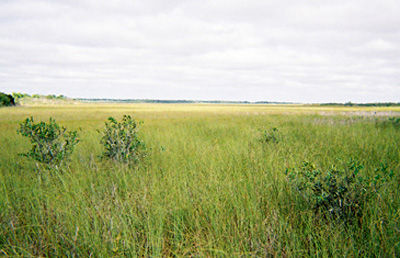 |
The end of the trail leads visitors to what was officially named “the River of Grass” (Photo by Adriana Martinez). |
In Royal Palm, there is the Anhinga Trail, which offers a relaxing stroll though the nature that is rare in other locations of the park and the Gumbo-Limbo Trail. Bill McCreary, the Everglades National Park ranger in charge of the tour, explained that this area is where a lot of the animal life can be seen.
According to the National Park Service website, http://www.nps.gov/ever, ranger-led tours are available at 10:30 a.m. daily and at 3:30 p.m. on Mondays, Wednesdays, Fridays and Saturdays. The trail is 0.8 miles and lasts 50 minutes. The Gumbo-Limbo Trail, less than 0.5 miles, is 30 minutes and consists of trees, ferns and orchids.
“The reason why I come is for the natural beauty and the wildlife,” said Michael Tobolski, a visitor from Washington, D.C. “Just seeing all these animals helps reconnect with nature.”
The Anhinga Trail is a walking tour that first takes you through the many gumbo limbo trees that decorate either side of the wooden walkway. McCreary said that what is unique about these trees is that in whatever area they are planted, growth is always a guarantee. Along with the trees, what also makes the trail unique is that the wood is made of composite or recycled grocery bags, which keep the wood from rotting.
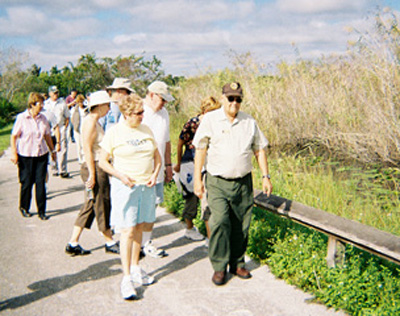 |
Leader of the Anhinga Trail, Bill McCreary, shows the visitors from all parts of the world the uniqueness of the trail compared to other areas (Photo by Adriana Martinez). |
Rare flowers are found in this area, like the swamp morning glory and the rare Indian morning glory, bright pink in color with large, fragile petals that is only found in South Florida and India. A large white flower, known as the swamp lily can also be spotted all over the trail.
“It is important for my kids to see nature, wild life and the strange plants,” said Alexander Weiss, a vacationer from Germany who brought his whole family. “I am planning on canoeing and doing the hikes but I wanted to see the nature first.”
The cormorant a bird that is covered in black feathers that fade into a soft white begins to make it usual appearance in November. Large numbers of anhinga can also be spotted throughout the trail with their light brown feathers and yellow necks.
During the tour, McCreary made sure to explain the details of the nature and clarified that the anhinga often puts its wings up after swimming in the river that wraps around the trail to warm up. He also noted that the river flows about 100 feet a week.
| An alligator sleeps at water’s edge (Photo by Adriana Martinez). |
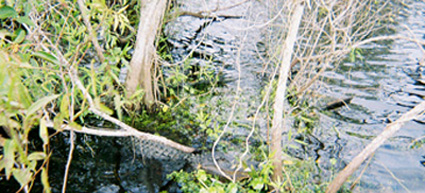 |
“I liked how informative the tour guide was,” said James Goad, a Miami resident. “It’s funny, you come here and find out things you never knew about your home.”
Goad said he was impressed by all of the vegetation that he never knew about in the Everglades, like trees that have red berries growing on them that are actually wild coffee and the giant leather fern that has pores that look and feel like leather.
Many of the visitors are eager to see the famous reptile that inhabits the park, the alligator. Along the trail there could be as many as four spotted at one time.
There is a gator that was seen during the tour that was about three and a half meters long and 400 pounds.
“Gators can outrun or out swim anything in the park,” said McCreary. He also explained that one of their traits is to dig holes with their tales in rocks to collect water when it rains. At a certain season this becomes the only water available in the park.
“I have visited many parks and this one is very well organized and maintained,” said Jaeamarc Pikarb, a visitor from France who was in South Florida on vacation. “It is very clean and the water is very clear.”
|
At right, air plants, very common at the Anhinga Trail, sit at the tops of trees for survival. Below, the Cormorant, who makes its appearance in November, is known for taking strolls on the backs of gators in the river (Photos by Adriana Martinez).
|
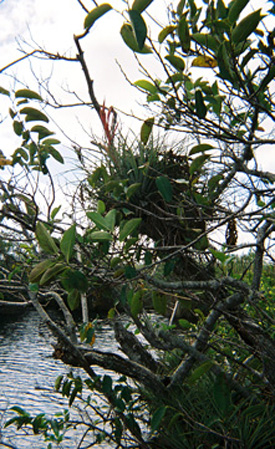 |
At the end of the trail you run into what was named the “river of grass” by environmentalist and Everglades legend Marjory Stoneman Douglas. It is called the Savannah Prairie by others.
McCreary explained that, at a certain time of the year, the whole area burns and puts nutrients back into the environment and rids the park of exotics. This process is needed and poses no major concern because everything in the trail is fire resistant and always grows back.
“Every month this park is totally different,” said McCreary. “Right now the Glades are at their prime.”
If You Go
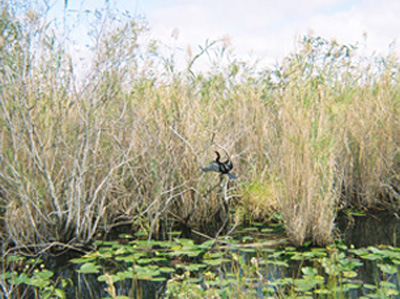 Ernest F. Coe Visitor Center located on State Road 9336 at the park’s main entrance. Open 8 a.m. to 5 p.m. December-April and 9 a.m. to 5 p.m. May-November.
Ernest F. Coe Visitor Center located on State Road 9336 at the park’s main entrance. Open 8 a.m. to 5 p.m. December-April and 9 a.m. to 5 p.m. May-November.
Royal Palm Nature Center located four miles from main entrance and provides access to Anhinga Trail and the Gumbo-Limbo Trail
The park has various entrances, when coming from the east, the park’s main entrance is 10 miles southwest of Florida City and Homestead, Florida on route 9336.
From the North, the Shark Valley entrance is 35 miles west of downtown Miami on U.S. Route 41.
From the West is the Gulf Coast Visitor Center, located at Everglades City 70 miles west of Downtown Miami.
Before entering the park each private vehicle has to pay a $10 fee that lasts seven days. Hikers and cyclists must pay a $5 fee. The annual park pass is $25.
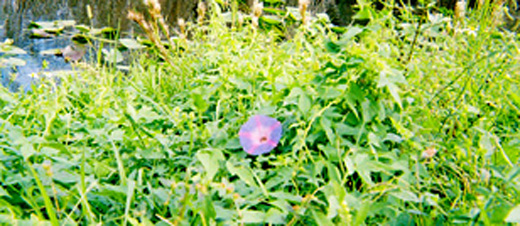
The Indian Morning Glory (Photo by Adriana Martinez).

Comments are Closed